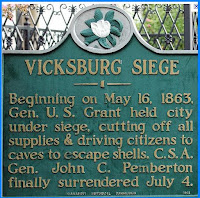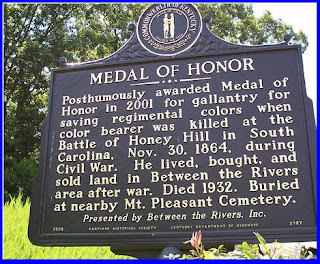By 1863, the recruitment of black men to join the Union Army was fervent. The Emancipation Proclamation issued in January 1863, was directed exclusively to the states that had seceded from the Union. Therefore border states like Maryland, Kentucky and Missouri were not included. So technically, slaves in Missouri were not affected by the proclamation. Prior to the official establishment of the Bureau of Colored Troops, fugitive slaves were not officially recruited in Missouri into the Union Army.
However, once Union Army recruitment of black soldiers had begun in earnest, slaves were no longer returned to their owners, if runaways had been found. So therefore, in Missouri as Federal forces had advanced, slaves in Missouri, like their brethren in the deep south, fled to the Union lines, and when opportunity came, they eagerly enlisted. Some were possibly inspired by the presence of black Union men as early as 1862, when the 1st Kansas Colored became involved in the
Battle of Island Mound. They would become the first black soldiers to engage the enemy.
18th US Colored Infantry
Organized in Missouri at large February 1 to September 28, 1864. Attached to District of St. Louis, Mo., Dept. of Missouri, to December, 1864. Unassigned, District of the Etowah, Dept. of the Cumberland, December, 1864. 1st Colored Brigade, District of the Etowa, Dept. of the Cumberland, to January, 1865. Unassigned, District of the Etowah, Dept. of the Cumberland, March, 1865. 1st Colored Brigade, Dept. of the Cumberland, to July, 1865. 2nd Brigade, 4th Division, District of East Tennessee and Dept. of the Tennessee, to February, 1866.
Service--Duty in District of St. Louis, Mo., and at St. Louis until November, 1864. Ordered to Nashville, Tenn., November 7. Moved to Paducah, Ky., November 7-11, thence to Nashville, Tenn. Occupation of Nashville during Hood's investment December 1-15. Battles of Nashville December 15-16. Pursuit of Hood to the Tennessee River December 17-28. At Bridgeport, Ala., guarding railroad until February, 1865. Action at Elrod's Tan Yard January 27. At Chattanooga, Tenn., and in District of East Tennessee until February, 1866. Mustered out February 21, 1866.
62nd US Colored Infantry
Organized March 11, 1864, from 1st Missouri Colored Infantry. Attached to District of St. Louis, Dept. of Missouri, to March, 1864. District of Baton Rouge, La., Dept. of the Gulf, to June, 1864. Provisional Brigade, District of Morganza, Dept. of the Gulf, to September, 1864. 2nd Brigade, 1st Division, United States Colored Troops, District of Morganza, Dept. of the Gulf, to September, 1864. Port Hudson, La., Dept. of the Gulf, to September, 1864. Brazos Santiago, Texas, to October, 1864. 1st Brigade, 2nd Division, United States Colored Troops, Dept. of the Gulf, to December, 1864. Brazos Santiago, Texas, to June, 1865. Dept. of Texas to March, 1866.
Service--Ordered to Baton Rouge, La., March 23, 1864, and duty there until June. Ordered to Morganza, La., and duty there until September. Expedition from Morganza to Bayou Sara September 6-7. Ordered to Brazos Santiago, Texas, September, and duty there until May, 1865. Expedition from Brazos Santiago May 11-14. Action at Palmetto Ranch May 12-13, 1865. White's Ranch May 13. Last action of the war. Duty at various points in Texas until March, 1866. Ordered to St. Louis via New Orleans, La. Mustered out March 31, 1866.
65th US Colored Infantry
Organized March 11, 1864, from 2nd Missouri Colored Infantry. Attached to Dept. of Missouri to June, 1864. Provisional Brigade, District of Morganza, La., Dept. of the Gulf, to September, 1864. 2nd Brigade, 1st Division, United States Colored Troops, District of Morganza, Dept. of the Gulf, to February, 1865. 1st Brigade, 1st Division, United States Colored Troops, District of Morganza, La., Dept. of the Gulf, to May, 1865. Northern District of Louisiana and Dept. of the Gulf to January, 1867.
Service--Garrison duty at Morganza, La., until May, 1865. Ordered to Port Hudson, La. Garrison duty there and at Baton Rouge and in Northern District of Louisiana until January, 1867. Mustered out January 8, 1867.Regiment lost during service 6 Officers and 749 Enlisted men by disease.
67th US Colored Infantry
Organized March 11, 1864, from 3rd Missouri Colored Infantry. Attached to Dept. of Missouri to March, 1864. District of Port Hudson, La., Dept. of the Gulf, to June, 1864. Provisional Brigade, District of Morganza, Dept. of the Gulf, to September, 1864. 2nd Brigade, 1st Division, United States Colored Troops, District of Morganza, Dept. of the Gulf, to February, 1865. 1st Brigade, 1st Division, United States Colored Troops, District of Morganza, Dept. of the Gulf, to May, 1865. Northern District of Louisiana, Dept. of the Gulf, to July, 1865.
Service--Moved from Benton Barracks, Mo., to Port Hudson, La., arriving March 19, 1864, and duty there until June. Moved to Morganza, La., and duty there until June, 1865. Action at Mt. Pleasant Landing, La., May 15, 1864 (Detachment). Expedition from Morganza to Bayou Sara September 6-7, 1864. Moved to Port Hudson June 1, 1865. Consolidated with 65th Regiment, United States Colored Troops, July 12, 1865.
68th US Colored Infantry
Organized March 11, 1864, from 4th. Missouri Colored Infantry. Attached to District of Memphis, Tenn., 16th Corps, Dept. of the Tennessee, to June, 1864. 1st Colored Brigade, Memphis, Tenn., District of West Tennessee, to December, 1864. Fort Pickering, Defenses of Memphis, Tenn., District of West Tennessee, to February, 1865. 3rd Brigade, 1st Division, United States Colored Troops, Military Division West Mississippi, to May, 1865. 1st Brigade, 1st Division, United States Colored Troops, District of West Florida, to June, 1865. Dept. of Texas to February, 1866.
SERVICE--At St. Louis, Mo., until April 27, 1864. Ordered to Memphis, Tenn., and duty in the Defenses of that city until February, 1865. Smith's Expedition to Tupelo, Miss., July 5-21, 1864. Camargo's Cross Roads, near Harrisburg, July 13. Tupelo July 14-15. Old Town Creek July 15. At Fort Pickering, Defenses of Memphis, Tenn., until February, 1865. Ordered to New Orleans, La., thence to Barrancas, Fla. March from Pensacola, Fla., to Blakely, Ala., March 20-April 1. Siege of Fort Blakely April 1-9. Assault and capture of Fort Blakely April 9. Occupation of Mobile April 12. March to Montgomery April 13-25. Duty there and at Mobile until June. Moved to New Orleans, La., thence to Texas. Duty on the Rio Grande and at various points in Texas until February, 1866. Mustered out February 5, 1866.
Battles Fought in Missouri Involving US Colored Troops
There were not many battles involving black soldiers fought in Missouri. Most of the regiments organized in the state were sent to other places such as Mississippi, Louisiana and Tennessee. The two most significant battles in which black Union Soldiers, were Island Mound and Glascow Missouri. Those battles would involve soldiers from other states, with exception of Glascow.
Missouri Civil War Battles involving black soldiers
Glascow, Missouri October 15, 1864 involving the 62nd US Colored Infantry
Island Mound, Missouri 1962 involving the 1st Kansas Colored Infantry (re-designated as 79th US Colored)
Sherwood, Missouri May 18, 1863 involving the 79th US Colored Infantry (formerly 1st Kansas Colored)
Military Service Muster In Document of US Colored soldier of Missouri







































